ULTIMATE LAT WORKOUT FOR A BIGGER BACK
THE ULTIMATE LAT WORKOUT FOR A BIGGER BACK:
If your back is a weakness, This back-building workout will help you add size, thickness, and strength:
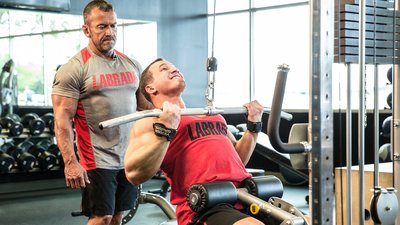
Since then, I've been working on building my back to bigger and better proportions. It's taken a lot of intense and consistent effort, but it's definitely paid off.
Today, you'll be going through a back workout with me and my dad. However, before you head straight to the lat pull-down machine, remind yourself to move the weight by squeezing your lats instead of pulling with your arms or using momentum. If you just pull with your arms, you'll go through an entire workout of glorified biceps curls. That won't get you anywhere.
Straight-Arm Lat Pull-Down
This exercise really captures the function of the lat muscle. The lat brings the humerus (upper arm bone) down and back, which is exactly what you're doing throughout this movement.
Keep a light bend in your elbows, but don't change your torso angle. The motion should come from the shoulder joint. At the top of the movement, you should feel an intense stretch in your lats; at the bottom, push your chest through. Don't use anything but your lats to move the weight.
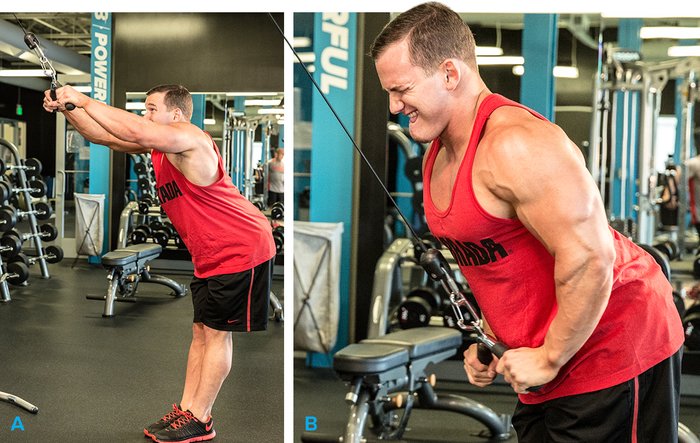
Straight-Arm Pull-Down
We're pairing this movement with the low-cable row in a superset to pre-exhaust the lats and get a lot of blood into the muscles. The more blood in the muscle, the harder that squeeze will be, because the muscle is so full.
I'm a really big proponent of stretching between sets. So, between your super-sets, grab whatever you can and pull on those lats. You're going to get super tight doing this super-set.
Seated Low-Cable Row
Get a full stretch in the extended position of this exercise by allowing your lats to stretch forward. On the way back, your back should rarely go beyond a 90-degree angle. Pull hard with your elbows, not your lower back.
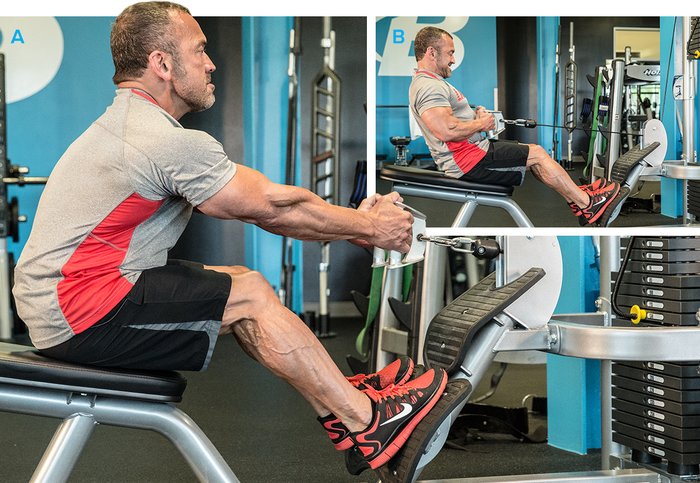
Seated Low-Cable Row
Keep your chest high during all of your back movements. If you let it drop, you're more likely to start pulling with your biceps.
Reverse-Grip Lat Pull-Down
Stay fairly upright and pull the bar all the way to your chest. Doing this movement with a reverse grip allows you to pull the elbows down easier because you're in a really natural angle. Pulling your elbows down hard will provide a deep, full contraction. At the top of the rep, put your head through your arms. That allows you to fully stretch and elongate your lats.
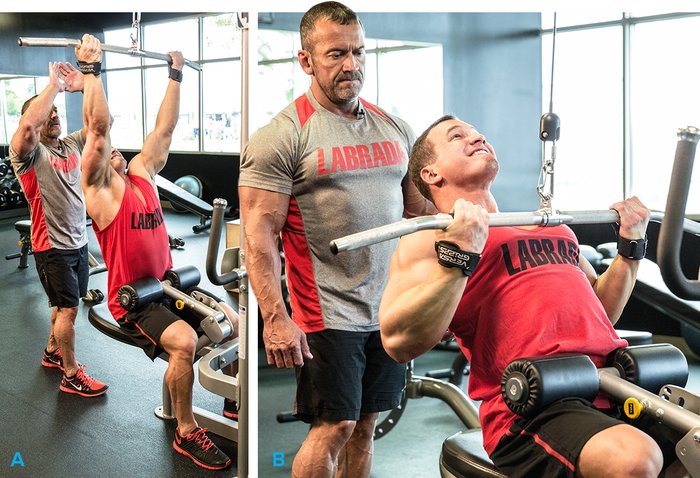
Reverse-Grip Lat Pull-Down
Your grip width on this exercise comes down to personal preference. I like to have my hands in line with my shoulders. That way it's a straight pull and puts less strain on my wrists. No matter where your hands are, though, the important thing is to get your elbows down and back, and to keep your chest high.
Reverse-Grip Barbell Row
Much for the same reason we do reverse-grip pull-downs, reverse-grip rows allow the most natural position and the biggest, deepest pull and contraction. When you do a row with an overhand grip, sometimes your elbows can "chicken wing" out and away from the body.
A lot of people want to move their torso up high as they row. That's unnecessary. If you're coming high, it's because the weight is too heavy. Stay over the bar. Your back angle should never change.
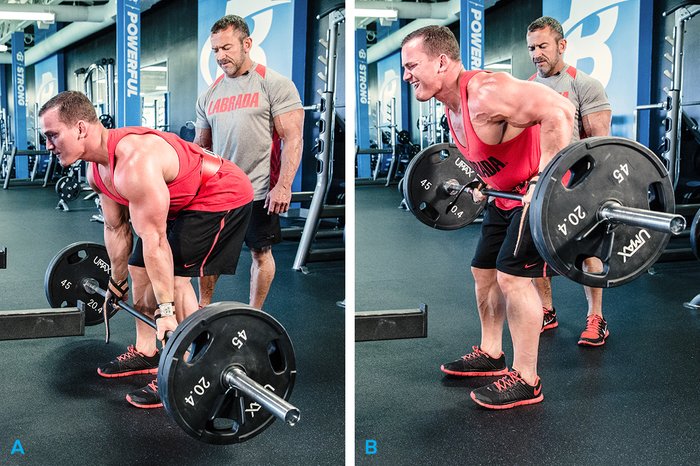
Reverse-Grip Barbell Row
Keep your head in a neutral position, aligned with your spine. Don't crank your neck up so you're looking at the ceiling. Your head position will keep your spine at a nice, flat angle.
The bar should stay close to your thighs. Drag the bar up your legs and pull it into your belly button.
This is one of those exercises that people can get too excited about and add too much weight. A lot of the time it's not the size of the tool, but how you use it. Use enough weight to really feel that contraction in your back, but not so much that you have to use other muscle groups to move it.
Close-Grip Lat Pull-Down
This movement differs from a regular lat pull-down because you're going to sit facing away from the weight stack. Instead of putting your knees under the pads, wedge your butt beneath them and keep your lower back flat against them.
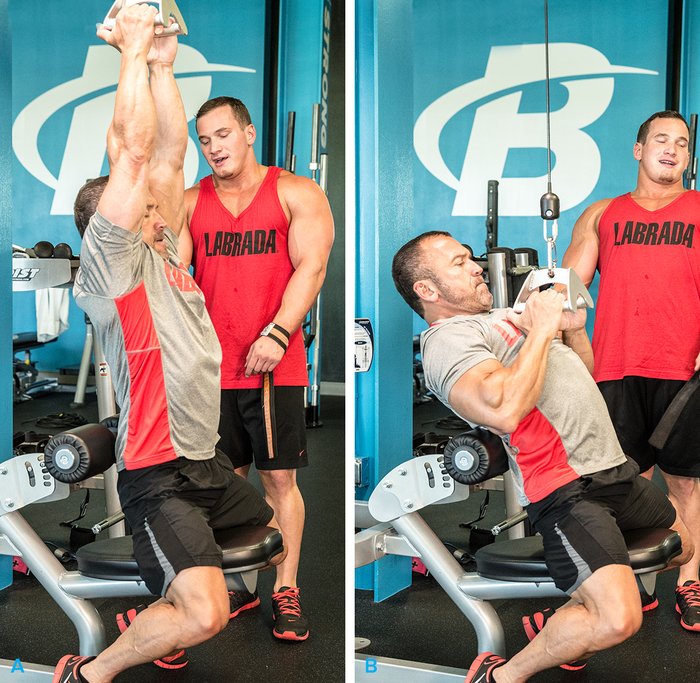
Close-Grip Lat Pull-Down
That position should take out all of the extra motion and keep your lats totally isolated. Really focus on the stretch, and then pull the bar all the way to your chest.
You will after trying these novel variations of staple back-building movements like the pull-down, pull-up, and row!
Your workouts can sometimes feel like a meal you've been eating every day for years. On back day, it's rows and pull-downs. Next time, rows and pull-ups. And for the truly inspired, flip the script and you've got pull-ups and rows.
But not today. Instead of serving the same ol' dish, we fired the chef and came up with a menu of all-new back-day fare. So let's toss out the old—including this tired kitchen metaphor—with six new exercises worth a try in your back workout.
You will after trying these novel variations of staple back-building movements like the pull-down, pull-up, and row!
Your workouts can sometimes feel like a meal you've been eating every day for years. On back day, it's rows and pull-downs. Next time, rows and pull-ups. And for the truly inspired, flip the script and you've got pull-ups and rows.
But not today. Instead of serving the same ol' dish, we fired the chef and came up with a menu of all-new back-day fare. So let's toss out the old—including this tired kitchen metaphor—with six new exercises worth a try in your back workout.
Single-Arm Long-Bar Row
This variation of the single-arm dumbbell row uses a barbell anchored at one end, either into a landmine hosel or into a corner (with some towels to keep the wall from getting chewed up). Some people find this setup allows them to achieve a greater range of motion than either the barbell or dumbbell provides. You can also load this surprisingly heavily.
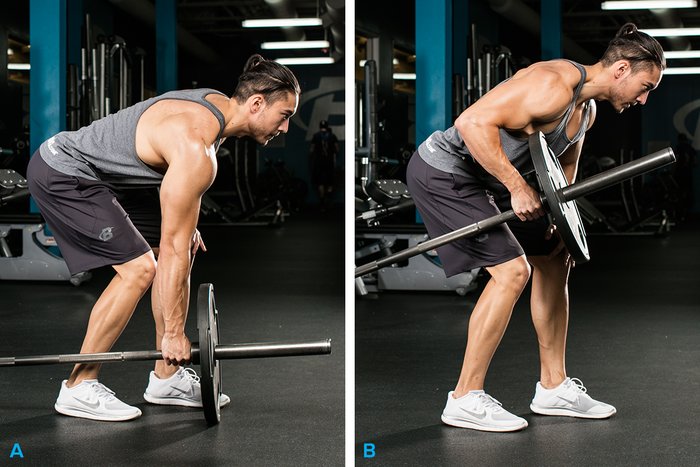
Single-Arm Long-Bar Row
About this move: Set up so the barbell is along your side (an alternate version with the barbell perpendicular to you is known as a "Meadows row"). With your chest up and back flat, bend over and grasp the bar near the collar with a neutral grip, keeping your knees bent. Pull your elbow as high as possible, but don't twist your body; keep it square and facing forward. Always keep your head neutrally aligned as well.
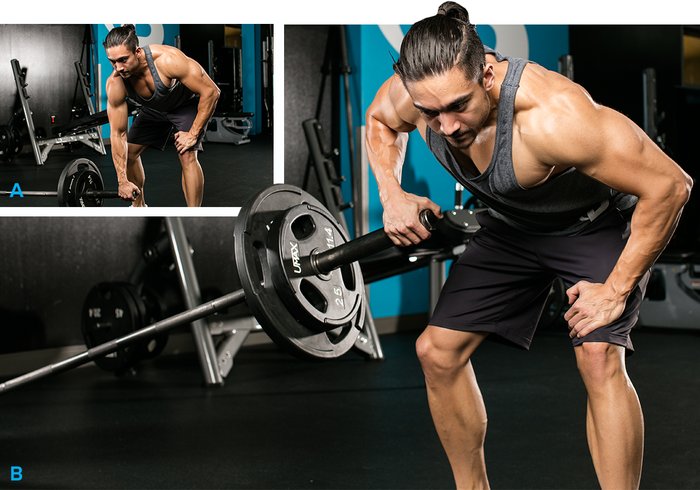
Meadows Row
If you have trouble maintaining a flat back, consider a split stance (inside foot back) while placing your outside elbow across your outside knee for added back support.
This variation of the single-arm dumbbell row uses a barbell anchored at one end, either into a landmine hosel or into a corner (with some towels to keep the wall from getting chewed up). Some people find this setup allows them to achieve a greater range of motion than either the barbell or dumbbell provides. You can also load this surprisingly heavily.

Single-Arm Long-Bar Row
About this move: Set up so the barbell is along your side (an alternate version with the barbell perpendicular to you is known as a "Meadows row"). With your chest up and back flat, bend over and grasp the bar near the collar with a neutral grip, keeping your knees bent. Pull your elbow as high as possible, but don't twist your body; keep it square and facing forward. Always keep your head neutrally aligned as well.

Meadows Row
If you have trouble maintaining a flat back, consider a split stance (inside foot back) while placing your outside elbow across your outside knee for added back support.
Decline Dumbbell Pull-Over
The decline position of this version of the pull-over places more focus on the lats than the flat-bench pull-over while reducing the degree of stress on the chest. Not only will you achieve a greater range of motion than the flat-bench version, but also greater time under tension on the lats—the lower lats in particular, in my experience.
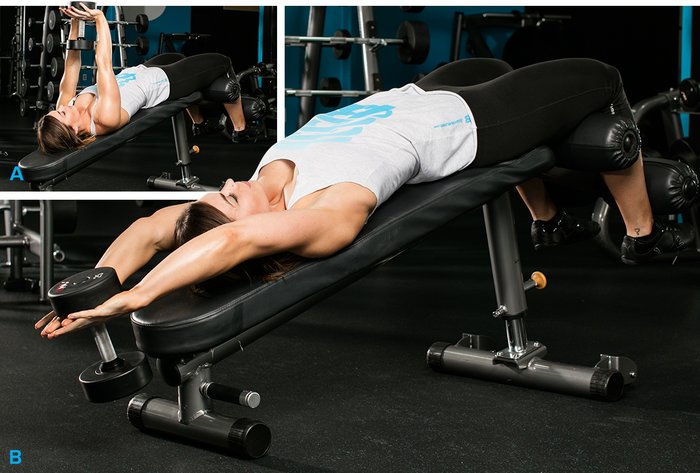
Decline Dumbbell Pull-Over
About this move: Choose a bench that has about a 45-degree decline, and set a single dumbbell on the ground at its base. Hook your legs under the rest, and reach back for the weight. Your arms should be nearly straight, but your elbows should be unlocked and stay in more or less the same position throughout the movement. Pull the weight up to a point somewhere over your chest, really focusing on pulling with your lats.
Key training tip: This is a single-joint movement, so don't try to turn it into a powerlift. Go light, and do it last in your workout after all your other back exercises for 3 sets of 10-15 reps.
The decline position of this version of the pull-over places more focus on the lats than the flat-bench pull-over while reducing the degree of stress on the chest. Not only will you achieve a greater range of motion than the flat-bench version, but also greater time under tension on the lats—the lower lats in particular, in my experience.

Decline Dumbbell Pull-Over
About this move: Choose a bench that has about a 45-degree decline, and set a single dumbbell on the ground at its base. Hook your legs under the rest, and reach back for the weight. Your arms should be nearly straight, but your elbows should be unlocked and stay in more or less the same position throughout the movement. Pull the weight up to a point somewhere over your chest, really focusing on pulling with your lats.
Key training tip: This is a single-joint movement, so don't try to turn it into a powerlift. Go light, and do it last in your workout after all your other back exercises for 3 sets of 10-15 reps.
Negative Pull-Up
This isn't a new exercise perse but rather a technique applied to the pull-up. Here, the focus isn't on the concentric but rather the eccentric contraction. Resisting the negative gives a powerful contraction under stretch to the lat fibers, which is a great way to spur new growth. Plus, since you're stronger in the eccentric of a movement than the concentric, you should be able to really work your lats to exhaustion
This isn't a new exercise perse but rather a technique applied to the pull-up. Here, the focus isn't on the concentric but rather the eccentric contraction. Resisting the negative gives a powerful contraction under stretch to the lat fibers, which is a great way to spur new growth. Plus, since you're stronger in the eccentric of a movement than the concentric, you should be able to really work your lats to exhaustion
To do negatives, position a stool beneath you so you're able to stand or jump back to the top position, and take 3-5 seconds to lower yourself, going very slowly and under control. End your set when you can no longer control the descent or it takes fewer than about three seconds.
Don't give in to the temptation to do any positive reps—although this technique can definitely boost your pull-up numbers down the road. For now, really fight the descent—that's what this technique is all about.
To do negatives, position a stool beneath you so you're able to stand or jump back to the top position, and take 3-5 seconds to lower yourself, going very slowly and under control. End your set when you can no longer control the descent or it takes fewer than about three seconds.
Don't give in to the temptation to do any positive reps—although this technique can definitely boost your pull-up numbers down the road. For now, really fight the descent—that's what this technique is all about.
Single-Arm Cable Row
This row variation simply replaces the close-grip handle bar with a D-handle, so you're working each side individually. This change helps gives you more range of motion as well as more grip options: neutral (palm-in), overhand, underhand, or perhaps best of all, rotate your palm, turning it up (or down) as you pull, which gives you a whole new feeling.
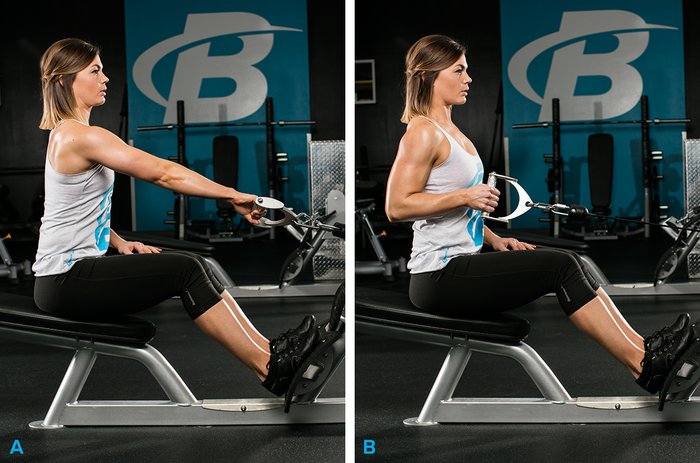
Single-Arm Cable Row
About this move Set yourself up like you're doing a seated cable row with your knees bent and back slightly arched, sitting up tall. Grasp the handle with one hand, pulling your elbow as far back as possible without twisting your body to the side. Retract your shoulder blade, and give the middle-back musculature a momentary squeeze before allowing the weight to pull your arm back to the start position.
Keep your body square to the unit rather than twisting your torso as you pull, which recruits the obliques into the motion. Maintain a fairly upright torso; leaning excessively forward and backward during the motion calls the lower-back musculature into the movement.
This row variation simply replaces the close-grip handle bar with a D-handle, so you're working each side individually. This change helps gives you more range of motion as well as more grip options: neutral (palm-in), overhand, underhand, or perhaps best of all, rotate your palm, turning it up (or down) as you pull, which gives you a whole new feeling.

Single-Arm Cable Row
About this move Set yourself up like you're doing a seated cable row with your knees bent and back slightly arched, sitting up tall. Grasp the handle with one hand, pulling your elbow as far back as possible without twisting your body to the side. Retract your shoulder blade, and give the middle-back musculature a momentary squeeze before allowing the weight to pull your arm back to the start position.
Keep your body square to the unit rather than twisting your torso as you pull, which recruits the obliques into the motion. Maintain a fairly upright torso; leaning excessively forward and backward during the motion calls the lower-back musculature into the movement.
Kneeling Isolateral Cable Pull-Down
Instead of using a lat pull-down station, here you'll change the angle of pull by positioning yourself on your knees between two upper pulleys (cable-cross-over station or Free-motion-type unit). You won't be using as much weight, because there's no way to anchor yourself down, but it's a great pumping movement for the end of your workout, and you'll really be able to cramp down on those lats.
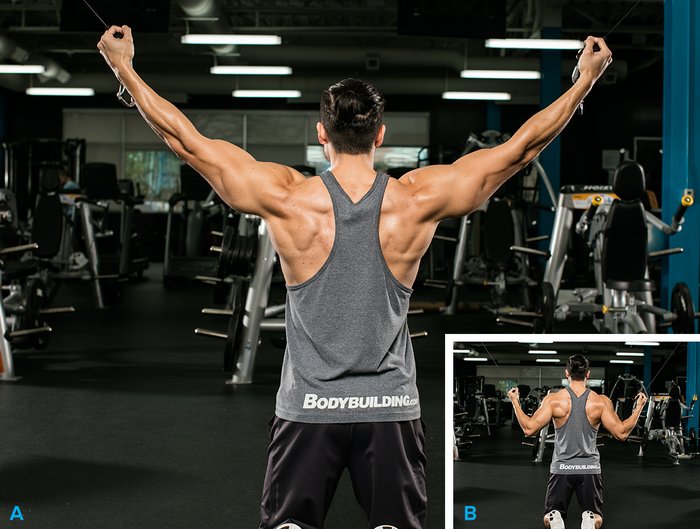
Kneeling Isolateral Cable Pull-Down
About this move: Set the cables to the top position, and take off the handles. That's right—you'll be grasping just the rubber balls. Walk over to each side and take the right-side cable in your right hand and left-side cable in your left, holding the ball between your thumb and index finger.
Center yourself, and drop to your knees, keeping your torso erect with your chest out. Rotate your hands so that your grip is slightly underhand. Smoothly drive your elbows into your sides, squeezing your lats in the peak-contracted position. Keep reps moderate to high, like 10-15.
Key training tip: Make sure you're positioned exactly midway and in line with the cables; if one side feels heavier than the other or the movement paths feel asymmetrical, you're probably off-center.
Instead of using a lat pull-down station, here you'll change the angle of pull by positioning yourself on your knees between two upper pulleys (cable-cross-over station or Free-motion-type unit). You won't be using as much weight, because there's no way to anchor yourself down, but it's a great pumping movement for the end of your workout, and you'll really be able to cramp down on those lats.

Kneeling Isolateral Cable Pull-Down
About this move: Set the cables to the top position, and take off the handles. That's right—you'll be grasping just the rubber balls. Walk over to each side and take the right-side cable in your right hand and left-side cable in your left, holding the ball between your thumb and index finger.
Center yourself, and drop to your knees, keeping your torso erect with your chest out. Rotate your hands so that your grip is slightly underhand. Smoothly drive your elbows into your sides, squeezing your lats in the peak-contracted position. Keep reps moderate to high, like 10-15.
Key training tip: Make sure you're positioned exactly midway and in line with the cables; if one side feels heavier than the other or the movement paths feel asymmetrical, you're probably off-center.
Single-Arm Smith Machine Row
With the bar locked in a set path, you don't need to worry about controlling the weight. Just load up and start hammering the lats! Because your elbow stays tight to your side as you pull, the emphasis is on the lower lats. This shouldn't be your primary row variation, but it's a great one for adding some heavy volume on your back day and emphasizing the stretch at the bottom.
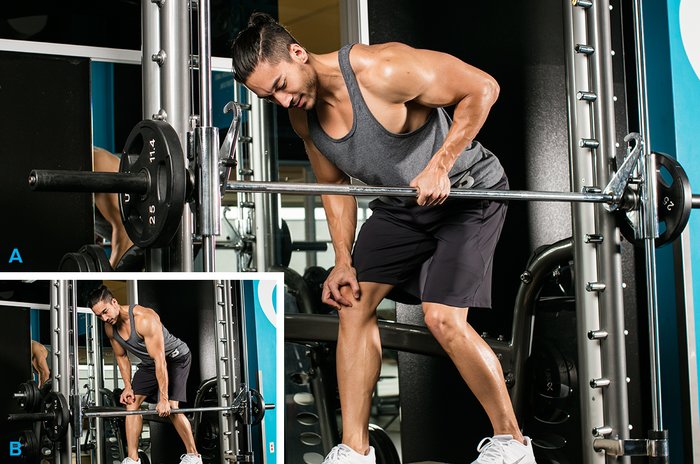
Single-Arm Smith Machine Row
It may seem as simple as can be, but getting your body set in the optimal position for pulling is still tricky. Set the bar near the bottom of the Smith apparatus, and disengage the safeties so the bar can approach the floor. Stand sideways to the unit, toward the center of the bar. Bend over about 45 degrees with a flat back, and place your outside hand on your knee for support. Use a split stance for balance with knees bent and your rear foot almost under the bar.
Grasp the bar near the center with your inside hand using a neutral grip, arm extended. Keep your shoulders square, chest out, and your back flat throughout. Don't rise up from the bent-over position as you pull the weight. Pull the bar upward by driving your elbow toward the ceiling and squeezing your shoulder blades together.
The bar should nearly graze your side as you pull it upward. Squeeze hard at the top for a count before slowly lowering to the start and feeling a good stretch in your lats.
This may feel awkward at first, so go light until you get the hang of the movement. Do this toward the middle of your workout, after your heavy bilateral rows or other strength work. Perform 3 sets of 8-12 reps
With the bar locked in a set path, you don't need to worry about controlling the weight. Just load up and start hammering the lats! Because your elbow stays tight to your side as you pull, the emphasis is on the lower lats. This shouldn't be your primary row variation, but it's a great one for adding some heavy volume on your back day and emphasizing the stretch at the bottom.

Single-Arm Smith Machine Row
It may seem as simple as can be, but getting your body set in the optimal position for pulling is still tricky. Set the bar near the bottom of the Smith apparatus, and disengage the safeties so the bar can approach the floor. Stand sideways to the unit, toward the center of the bar. Bend over about 45 degrees with a flat back, and place your outside hand on your knee for support. Use a split stance for balance with knees bent and your rear foot almost under the bar.
Grasp the bar near the center with your inside hand using a neutral grip, arm extended. Keep your shoulders square, chest out, and your back flat throughout. Don't rise up from the bent-over position as you pull the weight. Pull the bar upward by driving your elbow toward the ceiling and squeezing your shoulder blades together.
The bar should nearly graze your side as you pull it upward. Squeeze hard at the top for a count before slowly lowering to the start and feeling a good stretch in your lats.
This may feel awkward at first, so go light until you get the hang of the movement. Do this toward the middle of your workout, after your heavy bilateral rows or other strength work. Perform 3 sets of 8-12 reps

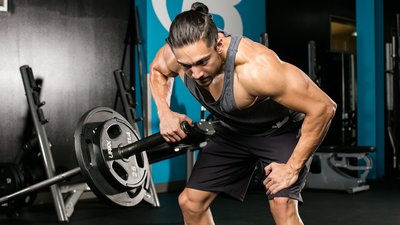

Comments
Post a Comment